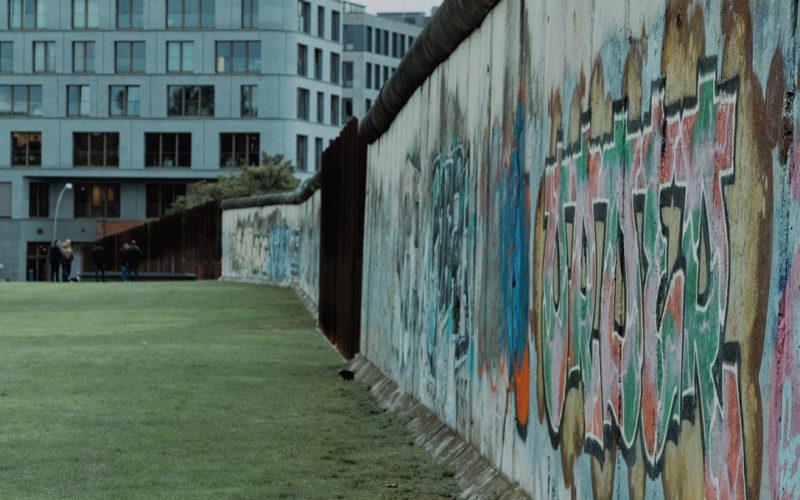Table of Contents Show
I. The Roots of Division: A City Split in Two
To understand the significance of the Berlin Wall’s fall, we must first grasp the historical context that led to its construction in 1961. The city of Berlin, a microcosm of Cold War tensions, was split into East and West after World War II. The aftermath of the war saw Germany divided into four occupied zones controlled by the United States, the Soviet Union, the United Kingdom, and France. Berlin, located deep within East Germany, became an epicenter of ideological conflict between capitalism and communism.
As the Cold War intensified, the disparity between the two halves of Berlin grew more pronounced. West Berlin, an isolated enclave of democracy and prosperity, contrasted sharply with East Berlin, which suffered under a repressive communist regime. The exodus of East Germans seeking better opportunities in the West posed a significant threat to the legitimacy of the East German government, the German Democratic Republic (GDR). By the late 1950s, more than 2.5 million East Germans had fled to the West, prompting fears among communist leaders that their regime was unsustainable.
In response to this growing crisis, East German leader Walter Ulbricht, with Soviet backing, made the fateful decision to construct the Berlin Wall. On August 13, 1961, barbed wire barricades were erected overnight, soon replaced by concrete walls and guard towers, effectively sealing off East Berlin from the West. The wall became a powerful symbol of the division that characterized the Cold War—a physical and ideological barrier that separated families, friends, and communities.
The wall’s construction was met with horror and disbelief. Images of desperate attempts to escape—fleeing through the wall, over it, or under it—captured the world’s attention. Those who were caught attempting to cross faced dire consequences, including imprisonment or death. The Berlin Wall not only divided a city but also embodied the broader struggle between two competing ideologies and the harsh realities of life under totalitarian rule.
II. A Decade of Repression: Life Behind the Wall
For nearly three decades, the Berlin Wall stood as a stark reminder of the oppressive nature of the East German regime. Life behind the wall was marked by surveillance, propaganda, and a pervasive sense of fear. The Stasi, East Germany’s secret police, maintained a stranglehold on society, employing a network of informants to monitor dissent and suppress any form of opposition. Citizens lived in a state of constant vigilance, aware that any expression of discontent could lead to severe repercussions.
The East German government implemented strict controls on travel, information, and communication. While the West prospered, the East faced economic stagnation and shortages of basic goods. The contrast between the two halves of the city became increasingly apparent, as West Berlin thrived with cultural vibrancy, economic opportunities, and democratic freedoms. In contrast, East Berlin remained cloistered, its citizens subject to indoctrination and censorship.
Despite these conditions, the desire for freedom and reunification simmered beneath the surface. The youth of East Germany, inspired by global movements for democracy, began to voice their frustrations. The 1980s witnessed a growing wave of dissent, fueled by grassroots movements, independent churches, and peace demonstrations. The most notable of these was the Monday demonstrations in Leipzig, where thousands gathered to demand political reform and an end to the regime’s oppressive policies.
As the winds of change swept through Eastern Europe in the late 1980s, the East German leadership faced increasing pressure. The fall of communism in neighboring countries, particularly Poland and Hungary, emboldened citizens in East Germany to push for change. The Iron Curtain was beginning to fray, and the calls for freedom and reform grew louder. Yet, the GDR’s leadership remained resolute in its commitment to maintain control, unaware that the time for change was rapidly approaching.
III. The Turning Point: Winds of Change and Popular Uprisings
The geopolitical landscape began to shift dramatically in the late 1980s. Mikhail Gorbachev’s ascent to power in the Soviet Union brought a new era of reform with policies of glasnost (openness) and perestroika (restructuring). Gorbachev’s reluctance to use military force to suppress dissent in Eastern Europe had a profound impact on the region, sparking hope among citizens yearning for change.
In East Germany, public protests intensified in the spring and summer of 1989. Thousands of citizens took to the streets, demanding greater freedoms and an end to the repressive regime. The government, faced with mounting pressure, began to make concessions, allowing limited reforms and greater access to Western goods. However, these measures were not enough to quell the growing discontent.
The tipping point came in October 1989, when massive demonstrations erupted across East Germany, culminating in a historic protest in Leipzig that drew over 70,000 participants. As the pressure mounted, the regime began to crumble. On November 9, 1989, in a fateful miscommunication, a government spokesperson announced that East Germans would be allowed to cross the border into West Berlin. The announcement, poorly phrased and unclear, sparked an immediate response.
Crowds gathered at the Berlin Wall, demanding to be let through. As news of the announcement spread, people poured into the streets, overwhelming border guards who were unprepared for the sheer volume of humanity. In an extraordinary moment of collective action, the wall was breached, and jubilant crowds flooded into West Berlin. The night of November 9th became one of unbridled celebration, as East and West Germans embraced, danced, and celebrated a shared victory over oppression.
IV. The Aftermath: Reunification and a New Era
The fall of the Berlin Wall marked a watershed moment in history, not only for Germany but for the entire world. It symbolized the triumph of freedom over tyranny and heralded the collapse of communist regimes across Eastern Europe. In the wake of the wall’s fall, the reunification of Germany became a central focus, as citizens sought to bridge the divide that had separated them for so long.
The process of reunification, formally completed on October 3, 1990, was complex and fraught with challenges. Economic disparities between East and West presented significant hurdles, as the newly reunified Germany sought to integrate two vastly different systems. The integration process required substantial investment and policy reforms to modernize the East German economy, which had lagged behind its western counterpart. The transition was often painful, leading to unemployment and social dislocation for many in the East.
Geopolitically, the fall of the Berlin Wall had far-reaching consequences. It marked the end of the Cold War and set the stage for a new world order characterized by the expansion of NATO and the European Union. Former Eastern Bloc countries sought to align themselves with Western democratic values, and the process of European integration gained momentum. The vision of a united Europe, free from the shadow of Soviet domination, began to take shape.
However, the legacy of the Berlin Wall and the Cold War did not fade away overnight. The transition to democracy in Eastern Europe faced significant challenges, including rising nationalism, economic inequality, and social tensions. The historical wounds inflicted by decades of division and repression continued to shape public consciousness and political discourse.
In Germany, the fall of the Berlin Wall remains a defining moment in national identity. The anniversary of the wall’s fall is commemorated as a celebration of freedom and unity, but it also serves as a reminder of the ongoing work required to address the disparities that still exist between the East and West. As the nation navigates its complex history, it remains committed to building a more inclusive and equitable society.
The fall of the Berlin Wall is not just a story of triumph; it is a testament to the enduring power of the human spirit in the face of oppression. It serves as a reminder of the importance of vigilance in protecting freedom and democracy, for history has shown that the forces of tyranny can re-emerge if left unchecked. The events of November 9, 1989, inspire us to strive for a world where walls are dismantled, and bridges are built, fostering understanding and cooperation among peoples and nations.
As we reflect on the fall of the Berlin Wall, we honor the courage of those who fought for their freedom and the transformative power of collective action. The lessons learned from this pivotal moment in history resonate today as we grapple with ongoing struggles for justice and human rights around the world. The fall of the Berlin Wall remains a beacon of hope, reminding us that change is possible, and the pursuit of liberty is a universal aspiration that transcends borders and divides.









